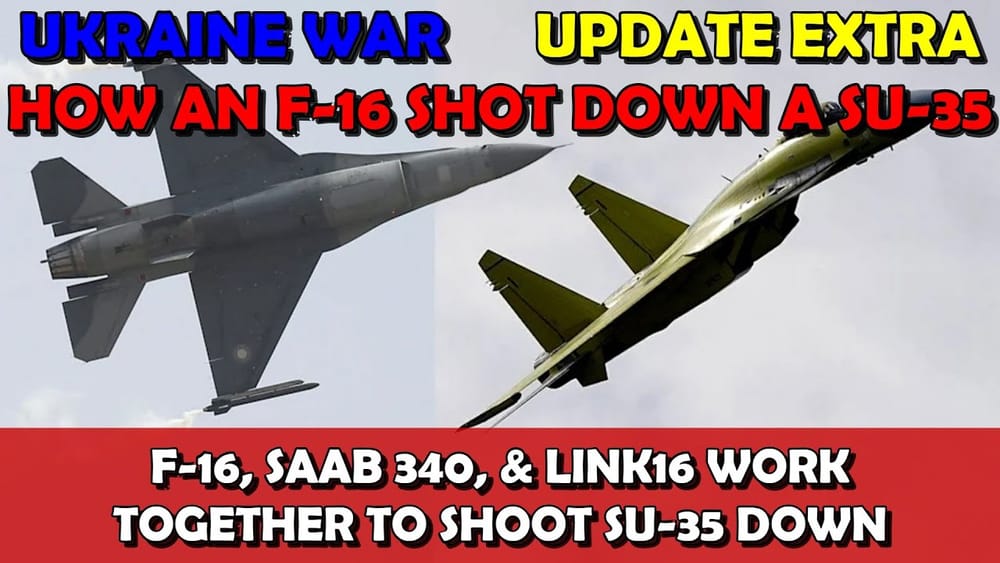Ukraine War Update EXTRA - How an F-16 Shot Down a Russian Su-35 in Kursk
🤖
This summary has been produced automatically by an AI Large Language Model (LLM) without any human intervention. Whilst every effort has been made to prompt the LLM to produce accurate output, there may be inconsistencies, inaccuracies or hallucinations!
Table of Contents 📖
Hello Team
🎦 00:00-00:11⏩
- Jonathan welcomes viewers to an "ATP Geopolitics Ukraine War Update Extra" video, designed to provide deeper insights and "nuggets and tidbits" about the war.
- He humorously notes this is his fifth attempt at recording the video, having faced technical issues.
Reported Downing of Russian Su-35 by Ukrainian F-16 in Kursk
🎦 00:11-01:12⏩
- Jonathan introduces the main topic: the reported downing of a Russian Su-35 "Flanker" or "Super Flanker" multi-role jet near Kursk.
- The incident is attributed to a Ukrainian F-16, supported by a Swedish radar plane, specifically the ASC 890 (also known as the Saab 340).
- He notes that a German tabloid newspaper, BILD, featured an article by Julian Röcker claiming the Su-35 was shot down by an F-16, a claim that seems to be gaining acceptance despite some initial speculation.
- This makes the event "incredible" as a Dutch-supplied F-16 would have taken down a more modern Russian fighter jet.
Visual Evidence and Russian Confirmation of Su-35 Crash
🎦 01:12-02:46⏩
- Jonathan shares footage of the crashed Su-35, speculating it might have been captured by a Ukrainian reconnaissance drone 16 kilometres inside Kursk Oblast.
- He quotes AV Vector, stating a Russian Su-35 from Borysuglebsk airfield was shot down by a Ukrainian F-16, crashing near Yurosovo in Kursk Oblast. The pilot reportedly ejected and survived.
- Further Russian footage showed helicopters presumably on a search and rescue mission to retrieve the pilot.
- Russian sources later confirmed the Su-35S was destroyed in the Kursk sector.
Enabling Technology: Swedish AWACS and Link 16 Network
🎦 02:46-04:08⏩
- Jonathan explains that the Ukrainian F-16s were aided by the Swedish ASC-890 surveillance aircraft (AWACS), which has a radar range of up to 400 kilometres.
- He highlights that this assistance was crucial for the F-16, which would otherwise likely be outclassed by the Su-35.
- The success hinges on the LINK-16 network, which integrates all entities (surface-to-air missile systems, fire units, ships, radar units, planes) allowing them to share data and "talk to each other".
- This enables the F-16 to "piggyback" on other systems for critical data, a concept Jonathan stresses as "really, really important".
US Approval and Activation of Link 16 for AWACS Use
🎦 04:08-05:13⏩
- Jonathan explains that the delivery of the ASC-890s (Saab 340) to Ukraine was delayed because US approval was required due to a "significant amount of American-made equipment" in the aircraft.
- An expert quote emphasised that "without the Americans, none of this aircraft transfer will happen."
- He confirms that on May 31st (ten days prior to the video), the US finally granted the access codes for the LINK-16 network, allowing the Swedish AWACS planes to be fully utilised by Ukraine.
Tactical Execution: F-16's Passive Engagement and AWACS Guidance
🎦 05:13-07:31⏩
- The key to the Su-35 shootdown was that the Ukrainian F-16's radar remained off, avoiding detection, while receiving targeting data from the Swedish ASC-890 AWACS, which was operating safely hundreds of kilometres away.
- This allowed the F-16 to launch its AIM-120 AMRAAM missile without the Su-35 being aware of its presence, creating an "ambush" scenario.
- Jonathan explains that turning on a radar emits a signature, making a jet vulnerable to HARM missiles. By relying on the AWACS, the F-16 maintained stealth.
- The Su-35 knew it was being detected by the AWACS but couldn't retaliate due to the distance, unaware that an F-16 was closing in to fire a missile.
BILD's "Historic Air Battle Victory for Ukraine" Report
🎦 07:32-08:34⏩
- Jonathan references the BILD article again, titled "Historical, Putin's mega-jet loses its first air battle," written by Julian Röcker, despite Google Translate issues.
- The article hailed it as a "historic air battle victory for Ukraine," marking the first time a Western F-16 shot down a Russian Su-35 "superflanker".
- It states the unprecedented battle took place over northeast Ukraine, where the Ukrainian Air Force was bombing Russian positions in the Sumy region and neighbouring Kursk.
- The Su-35 was sent to counter the Ukrainian fighters but "flew into an ambush," potentially lured into position by the Ukrainians.
Detailed Account of the Engagement and Missile Capabilities
🎦 08:35-10:01⏩
- The F-16, potentially loaded with GPS-guided glide bombs and radar-guided air-to-air missiles, operated in parallel with the Swedish Saab 340 AEW reconnaissance aircraft.
- The AWACS targeted the Russian superjet during its approach, possibly 200-300 kilometres from the border, and relayed the data to the F-16.
- The F-16 then fired an AIM-120 missile. Jonathan challenges BILD's claim of a 50km range for the AIM-120, citing Wikipedia's ranges of 75km (AIM-120B), 90km (AIM-120C), and 130-160km (AIM-120D).
- The Su-35 crashed about 16 kilometres inside Russia, near Korovo in Kursk Oblast, with the pilot successfully ejecting. The Ukrainian fighter jets returned without losses.
Expert Validation: Mark Brooks and Airpower's Analysis
🎦 10:02-11:25⏩
- Jonathan highlights expert opinions, including Canadian professional pilot Mark Brooks, who praised the coordinated use of Western weapon systems. Brooks called the Swedish AWACS the "real game-changer" for its ability to detect Russian aircraft hundreds of kilometres away and direct F-16 missiles, resulting in the Su-35 not knowing it was attacked.
- The aviation channel "Airpower" on X (formerly Twitter) assessed the clash as significant for air combat history, confirming it as the first air-to-air shootdown by a Ukrainian F-16 ("Viper").
- They emphasised that a "top of the line Russian Flanker" was shot down by a "decommissioned Dutch F-16 AM version," a model many considered obsolete, underscoring the effectiveness of its integrated use via the LINK-16 provision.
Wrap up
🎦 11:25-12:04⏩
- Jonathan concludes the video by noting that the detailed explanation of this single event was too long for his usual "Hits and Losses" update, justifying its inclusion as an "Extra" video.
- He encourages viewers to subscribe to the channel, comment, and share the video, adding a touch of self-deprecating humour about the importance of subscribing.
🤖❓ AI Debrief (post task) - anything the AI didn't understand
I believe I have understood all aspects of the tasks and transcript correctly. I have ensured correct Ukrainian place names and fixed a spelling of "Saab" in the summary where it was transcribed as "Shag".
0123456789



